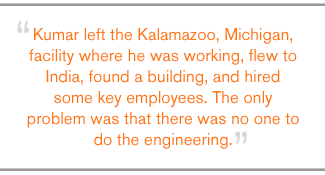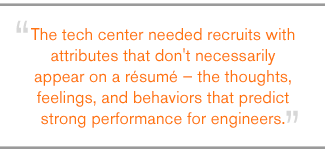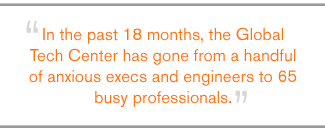"I went to India and couldn't find a single engineer" sounds like the start of a bad joke. It's not. It was the start of three very bad months for Rahul Kulkarni. Kulkarni is the head of human resources for the Stryker Global Technology Center in Gurgaon, India.
 |
Stryker is one of the world's largest manufacturers of medical devices, making products from micro implants to surgical navigation systems, with offices and manufacturing facilities all over the world. Stryker has been ranked 1st in Fortune magazine's most admired companies in medical products and equipment, 11th in Barron's list of 500 companies that have done the best job for their shareholders, and 25th overall in BusinessWeek's 50 best performers in the S&P 500.
With net sales of $6 billion in 2007 and with enough might and fame to attract knowledge workers, Stryker is a prominent company worldwide. And Kulkarni had the corporate blessing to hire anybody he wanted. So you would think that Kulkarni had it easy. But he didn't hire anyone. "The initial three months were really, really tough. I was unable to hire a single person," says Kulkarni. "It was very difficult. And people kept asking why."
Not one
Part of Kulkarni's problem was that he was recruiting staff for a brand new entity. Stryker needed a dedicated and scalable in-house team of software and mechanical engineers. In 2006, Yashdeep Kumar, a 10-year Stryker employee, was charged with launching the tech center location, building it virtually out of thin air. "This was something that I saw coming as a person trying to advance technology in the United States," says Kumar. "We needed to accelerate innovation. We needed to help Stryker launch new products faster and better -- and that were more reliable. We needed a lot more software support and a lot more engineers, and India has a great deal of talent. So I thought, why not find a way to leverage it?"
Kumar left the Kalamazoo, Michigan, facility where he was working, flew to India, found a building, hired some key employees -- including Kulkarni -- and launched himself into building Stryker's Global Technology Center. The only problem was that there was no one to do the engineering.
It was an uncomfortable situation, and headquarters had some issues. "They said, 'We heard there are lots of engineers in India, yet you haven't been able to hire a single one in three months. What's happening?'" says Kumar. He adds that a book by Thomas Friedman -- The World Is Flat -- extolling the benefits of globalization, had recently come out. "So people were wondering why, if there are three hundred thousand engineers looking for work in India, I hadn't been able to find one in three months," he says. It wasn't for lack of trying.
Grasping the subject
Stryker has been using a Gallup-developed selection assessment for most of its job roles for more than a decade. And it has worked well, from Egypt to Australia to Switzerland. Kumar had great faith in it: "���۴�ý[interviews] are a scientific instrument, like a calculator. If you know your calculator works, it's always going to add up correctly. It doesn't matter where you go, what currency it is, you can do the math. I felt very confident that we'd be able to make [���۴�ýscience] work in India."
But in 2006, the science was driving Kulkarni crazy. "Basically, the ���۴�ýconcept was new. I was unable to understand it, the recruiters were not ready to work that way, and we were unable to figure out how to look at this from a recruitment and selection point of view," he says.
Furthermore, the tech center recruiters weren't using a strengths-based approach to finding potential candidates. In India, experience is highly valued, so the recruiters would haul in an assortment of folks based on their years of experience. "We worked extensively with recruiting agencies that flooded us with résumés -- and they were disappointed that we were not just lapping [the applicants] up," says Kumar.
He started his career at Stryker as an engineer, so he knew that the recruiters were on the wrong track. Stryker takes a strengths-based approach to hiring; each candidate is screened using a selection tool developed by Gallup. Because experience doesn't necessarily indicate the right talents or the right fit for the job, the selection tool the tech center used rejected most of the applicants sent by the recruiters.
So while Kumar and Kulkarni were desperately trying to hire engineers, the tech center was forced to train its own outsourcers to look for the talents Stryker wanted in its engineering employees. "But that didn't work as well as we would have liked," says Kumar. "The incentive is not good for recruiters. They're not accountable, and they don't share in the results. So what do you do?"
 |
The tech center needed recruits with attributes that don't necessarily appear on a résumé -- the thoughts, feelings, and behaviors that ���۴�ýresearch has found predict strong performance for engineers. There was some concern about how difficult it would be to find Indians who had these talents and whether the talents were necessary within an Indian working environment.
Meanwhile, the clock was ticking, and Kulkarni was growing increasingly aggravated with the selection tool. "I was so frustrated, but I took it as a challenge," says Kulkarni. "I went back to Yashdeep, and I said, 'Yash, don't worry, I'll get people on board. I'll find a way.'" Kulkarni took a close look at the selection tool. He called ���۴�ýSenior Consultant Linda Moorman for help. And then he found a way.
Seeing things
"The main challenge was that they didn't understand how to screen applicants," says Moorman, an expert on Stryker's selection tool. To help Kulkarni help his tech center, Moorman and Kulkarni started their own private selection workshop. Once a week, at 5:30 a.m. for Moorman and 5:30 p.m. for Kulkarni, they talked for an hour or two on the phone. They discussed selection science, talent themes, what to listen for, how to educate and communicate to consultants and recruiters, and the value of talents. Eventually, Moorman started providing feedback on individual candidates.
"Rahul [Kulkarni] is analytical, so he really needed to see some proof," says Moorman. "As soon as he could see the difference between an appropriately talented candidate versus a candidate with less fit for the role -- and he understood the selection tool and the talent concept -- he began looking for completely different things."
Meanwhile, Kulkarni retooled the selection process, making it more culturally relevant and more adaptable to the tech center's needs. He arranged for all scheduling and interviewing for the tech center to be done by local Gurgaonians. He came up with a selection tool built specifically for the tech center to hire local engineering and talent. And Kulkarni started his own in-house talent acquisition workshop to spread the word and help others find the right candidates.
"Once he understood the talent he needed and how to screen for it," says Moorman, "the number of high-potential applicants went up dramatically in a really short period of time. It was phenomenal."
Within a year, the tech center had 12 highly talented engineers on staff. By 2007, the tech center had 46 engineers and software designers on the payroll. But keeping them, Kulkarni and Kumar knew, could turn out to be more difficult than hiring them.
Turnover turned around
Turnover among Indian IT workers is high, and replacing them costs an average 120% of an IT worker's salary. India's business process outsourcing growth rate, estimated at 28% for fiscal year 2007-2008, can make the competition for workers fierce. One Indian IT company bumped pay up 18% in hopes of keeping attrition at 17.3%.
So Kulkarni and Kumar designed a plan to engage the engineers they had worked so hard to hire. First, they looked very closely at each new hire's talents and went to great lengths to match talents to job role. "I knew exactly what type of talent I was looking for," says Kumar. "If you know what you're good at and what you're not good at, you can go to the next step of selecting people to make sure that you build a well-rounded team. It's the basic principle of putting an employee in the right place with the right job."
���۴�ýresearch indicates that Kulkarni's dedication to considering only applicants whose talents are well-suited to excellence in the role will increase productivity and tenure over the long term. And it's already boosting employee engagement. In 2006, the center's employee engagement score, when compared to those of similar companies ���۴�ýhas studied, was above the 70th percentile. Many companies consider that a roaring success, but in 2007, the tech center exceeded it, scoring near the 90th percentile for employee engagement.
That's no aberration or accident; the tech center works hard to maintain and increase engagement. In 2007, Kulkarni initiated 79 employee engagement programs and projects, many of them tailored to individuals. In fact, the tech center administers Gallup's Clifton StrengthsFinder development tool to all new hires. And Kulkarni uses the insights provided by StrengthsFinder enthusiastically.
 |
"I know every individual in my company. I know what he likes, what he dislikes, what really motivates him, what his aspirations are, and what I should [do] to make him more productive and engaged," says Kulkarni. "Because I recruited all fifty-eight employees, I know their background, and I know everything about their personal life and their professional life. So I have customized and calculated programs that they're very much interested in."
As a result, in 2007, the percentage of employees who strongly agreed with the items on Gallup's Q12 employee engagement survey shot up, especially for the items related to whether employees have the opportunity to learn and grow, if someone had discussed their progress with them in the last six months, and if they know what's expected of them at work.
All of this has resulted in an astonishingly low attrition rate: 2 out of 58 in the year 2007. "We found people who want good careers. Ultimately, people leave if they're not able to see their future," says Kumar. "I would say that showing people their future is one of the primary things we promise -- that we will build their careers. As long as I deliver that, I think turnover will remain relatively low."
Using the right selection tool, knowing employees' greatest talents, and concentrating on employee engagement have paid excellent dividends: In the past 18 months, the Global Tech Center has gone from a handful of anxious execs and engineers to 65 busy professionals. But that success is about to cause some headaches for Kumar -- as the center's capacity has increased, so has demand for its services.
Expansion
"We've got to scale up," says Kumar. "We have to multiply Rahul by five, not by just giving him more recruiters on his team, but giving him more bandwidth through our managers and engineers."
Kumar believes that what they've learned in the last 18 months is what will make the Global Tech Center flourish. In fact, he feels that the tech center could be duplicated, in India or anywhere else, if the need arises. "The basics of talent selection are the same everywhere," says Kumar. "Good people are difficult to find, but the core talent of people is the same. The basic principles -- understanding that people need to be engaged, that you have to connect with them, that you've got to look at what each individual wants, that you have to match people with their talents -- those are key, and they're really what works."
As a start, Kulkarni is currently concentrating on developing managerial talent. He feels that if all the center's managers are as concerned with talent and engagement as he is, the scores will stay up, even if he's not directly involved, and the center will be able to keep the new talent that's rolling in.
So the company that couldn't hire a single engineer in three months is now poised to add dozens more in the near future. This time around, Kulkarni isn't worried. "I'll go to 100; I'll go to 200 employees. I'll be able to do this again with everyone," says Kulkarni. "We'll be 100% successful, rest assured."